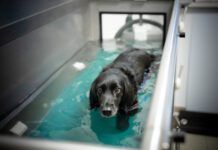By CJ Puotinen
The high-tech world of modern medicine has so many weapons that its “war on cancer” arsenal promises something for everyone. But all along, there have been patients, physicians, veterinarians, and animal caregivers who refuse chemotherapy, radiation treatments, surgery, prescription drugs, and other oncology protocols.
What do they use instead? Everything from an improved diet to homeopathy, medicinal herbs, vitamins, nutritional supplements, and energy therapies. The aim of all of these treatments, which are used singly or in combination, is to engage the healing properties of Mother Nature while avoiding debilitating side effects.

Rather than describe every alternative cancer treatment – an impossible task that would fill a book – we’ll describe several frequently used alternative therapies. These protocols tend to be simple and affordable, especially compared with conventional medical therapies. In some cases, they completely cured a dog’s cancer. In others, they significantly improved the patient’s quality of life, resulting in companionship and an active lifestyle for months or years beyond the original prognosis. Unfortunately, there are no guarantees, for no treatment always cures cancer or extends the patients’s life. Sometimes, nothing works.
If you decide to use one or more of these protocols, please do so with the help of a knowledgeable holistic veterinarian – or a sympathetic conventional vet – who can monitor your dog’s condition, document his or her progress, and provide support throughout the dog’s treatment.
This can be especially important when the patient goes through rapid detoxification or a so-called “healing crisis” – where the dog gets dramatically worse before getting better – something any natural therapy might trigger. “Information, encouragement, and assistance from someone who understands what’s going on can be a blessing, especially if the symptoms are unexpected or dramatic,” says trainer Nancy Strouss, of Nyack, New York, who has lost six Golden Retrievers and one black Lab to cancer.
For information on product sources, dosages, and specific recommendations, see the “Resources” sidebar.
Nutrition
Diet is so important in the treatment of cancer that all holistic veterinarians encourage their clients to improve the quality of their dogs’ food. Organizations like the Weston A. Price Foundation and your local farmer’s market or co-op can help you locate organic, pasture-fed ingredients, including raw or cultured dairy products.
Unlike products from factory farms, the meat and milk of pasture-fed animals contain conjugated linoleic acid, or CLA, which inhibits the development of tumors. Upgrading to pasture-fed ingredients can actually help your dog fight cancer.
As mentioned in “Don’t Despair, Just Care” (January 2006), carbohydrates feed cancer cells, while fats do not. This may explain why some dogs with cancer have responded well to a diet recommended for human patients by the late Johanna Budwig, PhD. A German pharmacologist, chemist, and physicist, Dr. Budwig is best known for her research on fats and oils and for her use of flaxseed oil and sulphur-rich quark cheese (a cultured dairy product similar to cottage cheese) to treat cancer. She advocated the use of nutrition, sunlight (a natural source of vitamin D), and stress management as a stand-alone alternative cancer treatment.
Five years ago, Misty, a German Shepherd Dog belonging to Craig Stauffer in Sunnyvale, California, developed mammary cancer. Following the biopsy of two tumors, Misty was given six months to live. “The recommended treatment was the removal of all mammary tissue followed by chemotherapy,” says Stauffer.
Instead, Stauffer researched alternatives and learned of Dr. Budwig’s treatment. He began supplementing Misty’s dog food with flax seed oil, cottage cheese, ground flax seed, garlic, and broccoli. Misty’s cancer disappeared, and she enjoyed an active, athletic lifestyle with no recurrence of the disease. “We lost her in May 2005 to old age,” Stauffer reports, “shortly before her 14th birthday.”
Because flax seed oil is highly perishable and quickly goes rancid at room temperature, this ingredient requires constant refrigeration. Coconut researcher Bruce Fife, ND (see “Crazy About Coconut Oil,” October 2005), suggests replacing the flax seed oil in this protocol with coconut oil. “Coconut oil is far more stable than flax seed oil,” he explains, “and it has significant anti-tumor properties.”
Carbohydrates feed cancer cells, so feed canine cancer patients a grain-free, low-carb or no-carb diet. (See “Feed the Dog, Starve the Cancer,” November 2003.)
Antioxidant supplements
Antioxidants are naturally occurring substances that protect cells from damage caused by oxygen molecules known as free radicals, which are believed to encourage the development of tumors. Antioxidants include beta-carotene (found in carrots, cantaloupe, and other orange-colored foods), vitamin E (found in nuts, wheat germ, and some vegetables), vitamin A (found in liver, egg yolks, and cod liver oil), vitamin C (found in citrus fruit, hot peppers, and leafy vegetables), and the mineral selenium (found in grains).
Human clinical trials suggest that synthetic vitamin E may contribute to, rather than prevent, certain illnesses, something that advocates of whole-food nutrition have long maintained.
Some herbs and nutritional supplements used in the treatment of cancer are (or are claimed to be) powerful antioxidants. Antioxidant supplements may be helpful in combination with most natural cancer treatments, but they can interfere with others. Be sure to study a protocol carefully before adding antioxidants, and for best results use food-source rather than synthetic products.
Other supplements
Melatonin, a hormone produced in the brain’s pineal gland in response to darkness, helps us sleep and has potent antioxidant properties. It is a popular treatment for canine thunder phobia and separation anxiety, and because it has been shown to help humans recover from breast and prostate cancer, it’s being given to some dogs with these conditions.
Several years ago, shark cartilage seemed to be the most promising alternative treatment for cancer, but uneven results, quality problems, insufficient research, and concern about the ecological effects of shark hunting reduced its popularity. Bovine cartilage shares similar properties, and some holistic veterinarians prescribe cartilage supplements for cancer.
When New Jersey resident Gayle Roberson’s 11-year-old Toy Poodle developed an almost non-stop gagging cough and a heart murmur, an X-ray revealed a major mass in his chest. None of the medications his veterinarian prescribed produced results, so Roberson experimented with bovine cartilage. “By the end of the first bottle, he was coughing less,” she says. “After the second, he was so much better that I had his chest X-rayed again. The mass had almost completely disappeared and his heart murmur was downgraded from a 5 to a 1. This was sensational, and he lived to be 17!”
Beta glucan (more correctly called Beta-1,3/1,6-Glucan) is a simple sugar derived from the cell wall of Saccharomyces ceresvsiae, common baker’s yeast. Researchers have been testing its immune-boosting properties since the 1940s.
Ted Keller, a registered pharmacist in Colorado, says he has seen dramatic results with beta glucan in human and animal cancer patients. “The best example I can give is a dog diagnosed with T-cell lymphoma and given six months to live. Thanks to beta glucan, the dog was still alive two years later, to the amazement of her veterinarians. . . . The earlier the diagnosis, the better the beta glucan works. For melanoma, beta glucan works wonders as long as it hasn’t metastasized to the brain.”
Herbal treatments
Search online for herbal cancer treatments and you’ll find thousands. A few are backed by serious research, some are hyped by multilevel-marketing companies, most are described with exaggerated claims, many have been used for centuries in traditional medicine, and some have saved dogs’ lives. Distinguishing one from the other requires careful study or the help of an herbalist.
Several reputable companies make herbal tonics, teas, extracts, and other products that help dogs fight cancer. Some contain medicinal mushrooms (such as maitake or reishi), aloe vera, cat’s claw, or Chinese herbs, all of which are highly regarded as natural cancer treatments. All You Ever Wanted to Know about Herbs for Pets, a terrific book by Mary Wulff-Tilford and Gregory Tilford, is helpful for anyone interested in treating pets botanically.
The Tilfords’ favorite anticancer herb is red clover, which, they say, inhibits the activities of carcinogenic compounds, helps improve blood structure, and strengthens lymphatic functions that are crucial in cleansing cell tissues throughout the body.
Red clover also contains plant sterol constituents that may inhibit the production of blood vessels that feed newly formed tumors. Herbs for Pets includes instructions for making a tonic/support formula for cancer patients by combining red clover, the Chinese immune-boosting herb astragalus, dandelion root (which gently stimulates the liver, improves digestion, and assists with the removal of waste), and garlic (which has its own anticancer, antitumor properties).
The herbal formula Essiac (described in “Don’t Despair, Just Care,” January 2006), is another tonic tea that enhances immune function and helps the body heal itself.
The yellow spice turmeric is becoming known as a cancer fighter, even by conventional medical practitioners. Turmeric’s key ingredient is curcumin, a phytopolyphenol pigment with anti-inflammatory, antioxidant properties. Curcumin helps starve tumors by disrupting their blood supply, and it stimulates the immune system, enhances cardiovascular function, and improves digestion. Some cases have been reported in which turmeric or curcumin caused tumors on a dog’s head or body to turn black and disappear.
We introduced WDJ readers to Australian herbalist Robert McDowell in “Buying Time to Spend Together” (October 1998), which described how McDowell helped Jet, a 10-year-old Belgian Shepherd, recover from bone cancer. The herbalist continues to work with canine cancer patients around the world. His standard approach to all cancers involves maritime pine bark extract, an immune system tonic, in combination with a specific support formula directed at the patient’s particular cancer. “Maritime pine is a special antioxidant nearly 25 times more powerful than vitamin C,” says McDowell.
Chinese herbs
Chinese herbal medicine is a primary component of Traditional Chinese Medicine (TCM). In conventional Western medicine, drugs are chosen for their ability to exert specific physiological actions; in TCM, the practitioner chooses treatments, including herbs, based on the manifestations of disease and energetic imbalances he detects in each individual’s body. In other words, a TCM practitioner may prescribe different herbs (and other treatments, including acupuncture) to different individuals with the same disease. Most of the herbs (and mineral or animal-based ingredients of predominantly herbal medicines) used by TCM practitioners have been used to treat people for thousands of years.
When Audrey Blake’s nine-year-old Golden Retriever, Dylan, was diagnosed with hemangiosarcoma in November 2002, Blake knew she didn’t want Dylan to undergo conventional therapy.
“Surgery wasn’t an option because his liver was involved, and I didn’t want to put him through chemotherapy,” says the Riverhead, New York resident. “Another factor was that two of my friends had just lost their Goldens to hemangiosarcoma. Both dogs died a few weeks after surgery. The odds weren’t good, so I decided that even if all we had was three months together, I wanted those months to be as comfortable as possible for him.”
Fortunately for Dylan, his veterinarian was Dr. Jiu Jia Wen, who majored in acupuncture and traditional Chinese herbal medicine at Beijing Agricultural University in China. Dr. Wen prepared a blend of 20 Chinese herbs that Blake added to Dylan’s food. The herbs were easy to administer and affordable, she says. By their next checkup, the tumor had stopped growing, and by the following month, it was shrinking.
“I was ecstatic,” says Blake. “Dylan was active, playful, and happy.” After about a year, the tumor began to grow again and a second herbal blend was added to his food. Eventually, the cancer won out, and Dylan died shortly before his 12th birthday.
“I still miss him,” says Blake, “but I have no regrets. I would use this same protocol again, and I recommend it to others. Older dogs and hemangiosarcoma are never a good combination, but the Chinese herbs worked incredibly well.”
Artemisinin
Three years ago, WDJ introduced readers to artemisinin, an extract derived from the Chinese herb Artemesia annua, also known as sweet Annie or annual wormwood (see “New Hope for Treating Cancer,” May 2003). A traditional cure for malaria, the plant is now a treatment for cancer. Like the parasite that causes malaria, cancer cells hoard iron in order to replicate their DNA. When artemisinin comes in contact with iron, it becomes a toxic chemical, releasing free radicals that destroy affected parasites or cancer cells.
For a while, it seemed artemisinin might be the magic bullet that would quickly cure cancer in humans and pets. In 2003, a research study was under way at the Washington Cancer Institute Department of Orthopedic Oncology at Georgetown University Medical Center, vets who used the herb were reporting promising results, and an “artemisinin and cancer” online forum attracted hundreds of members.
Now the dust is settling. The research study was cancelled for lack of funding, and not every dog who took artemisinin improved. In addition, some veterinarians worried about adverse side effects.
Despite these disappointments and concerns, artemisinin remains a popular alternative. Henry Lai, PhD, Narendra P. Singh, MD, and other researchers at the University of Washington, Seattle, have published artemisinin studies in peer-reviewed medical journals. Because of their solid theoretical and experimental results, even conventionally trained veterinarians take artemisinin seriously.
“I can think of at least three reasons why some dogs have not been completely cured of cancer by artemisinin,” Dr. Lai told us. “First, artemisinin treatment is usually started too late, when dogs are at an advanced stage of cancer. Second, I don’t think artemisinin is completely effective unless we can prolong its half-life of action and increase its selectivity. We are working on solutions for that problem, but they will be expensive. The third reason is that a lot of owners feed high doses of antioxidants such as vitamins C and E to their dogs, and antioxidants counteract the action of artemisinin.”
Artemisinin works as an oxidant, explains Dr. Lai; therefore its action is opposite that of antioxidants. “It is known that antioxidants decrease the effect of artemisinin on malarial parasites, and we have experimental data showing that this is also true for cancer cells. It seems that people in developing countries respond better to artemisinin than people in the U.S., possibly because they don’t take a lot of antioxidant supplements.”
Giving antioxidants to dogs several hours after artemisinin is one possible solution. “But some antioxidants, such as vitamin E, stay in the body for a long time,” says Dr. Lai, “so they would continue to counteract artemisinin. Stopping antioxidants during the initial phase of artemisinin treatment might produce better results.”
Even if cancer returns and causes the patient’s death, dogs on artemisinin often outlive their original prognosis. Kathy Rowley’s Greyhound, Tera, was diagnosed with a bone tumor in her lower left hind leg. “That was on a Tuesday,” Rowley recalls. “The following Saturday we started her on artemisinin. The next day she seemed to feel better, and on Monday she was bouncing off the wall and acting totally normal. We couldn’t believe it.
“Two weeks later our vet examined her leg and was shocked that she had no pain. He suggested we do X-rays in three months, even though we knew the odds of her still being alive in three months were slim. But she kept getting better, and after three months, the tumor had shrunk dramatically. The vet said he would not have believed it if he hadn’t seen it with his own eyes.”
Tera’s tumor didn’t disappear but it didn’t begin to grow again until the following spring. “We increased her dose of artemisinin,” says Rowley, “but for some reason it just stopped working. When pain began to incapacitate her, we knew it was time. Tera died in July 2004, shortly before her 10th birthday. The artemisinin might not have cured her, but the extra 14 months that we shared with our lively, happy dog were nothing short of a miracle.”
Cancer salves
Escharotic salves, often called black salves, were so popular in the early 20th century that entire hospitals were devoted to their use. The name comes from the eschar (thick dried scab) that develops after the salve destroys tissue to which it is applied. Most such salves contain bloodroot (Sanguinaria canadensis) and zinc chloride, a preservative said to enhance the effectiveness of the salve.
Holistic health guru Andrew Weil, MD, revived interest in cancer salves when he wrote about using one on his six-year-old Rhodesian Ridgeback, Coca, who developed a growth on her right side near the shoulder. Dr. Weil describes the experience in his book, Spontaneous Healing, concluding, “The end result was a perfectly circular, slightly depressed area of skin, with no trace of tumor. The bloodroot had removed it more neatly than one could have done with a scalpel. Later, hair grew over the spot, concealing it completely. I could not have asked for a better outcome, especially as the dog had shown no signs of discomfort.”

In humans, treatment with escharotics can be painful and scarring. While dogs tend to have higher pain thresholds than humans, this is still not a treatment to approach casually. Keeping the affected area bandaged and attending to its healing can be a challenge.
In 1998, Gail Tenney of Mahwah, New Jersey, learned that Jo, her 11-year-old mixed-breed dog, had mesenchymal neoplasm, a non-specific slow-growing cancer of the soft tissue. Jo had two tumors, one on a toe on her front foot, the other on a back leg.
“The oncologist I consulted said he would remove Jo’s leg and toe,” recalls Tenney. “I rejected that idea right away. Even surgery to remove the tumors without amputation could be dangerous because of her advancing heart disease and elevated liver enzymes. I had already used a black salve to remove a wart from the top of her head, so in March of 1999, I decided to try this method.”
The tumor on Jo’s foot, now the size of a walnut, responded just like Coca’s skin growth. The second, near her tail, was larger than a baseball. Following the advice of the salve’s distributor, Tenney asked Jo’s veterinarian to inject the tumor with salve diluted in saline solution.
“Exactly like the first tumor,” she recalls, “on the third day it started to turn hard and black, then began to peel away from her body. It bled all over her bed, and she really hurt. Even on pain pills, she whimpered. On the fifth day, the tumor fell off. What a mess! There was a huge opening on her leg with all kinds of green-yellow pus oozing from it. The open wound was the size of my fist.
“For two weeks I did nothing but clean up blood and attend to Jo 24 hours a day. Another vet I consulted told me to wash the wound twice a day and apply betadine. I used a garden hose to really clean the sore, but it still oozed fluid. What was interesting is that as soon as the tumor fell off, Jo seemed really happy with no discomfort at all, even when I touched the wound. Like the wound on her foot, it gradually healed.”
Jo died in January 2000, of congestive heart failure. “If I had it to do over,” says Tenney, “I would have used the salve right away, when the tumors were tiny. In general, I would say this is not a treatment for the faint-hearted, and the best way to do it is with the support of a sympathetic veterinarian.”
Patricia Weissleader, who lives near Palm Springs, California, has treated several of her rescued dogs with black salve. “In every case,” she says, “the salve removed the tumors and the dogs were healthy.”
Weissleader now runs an online group devoted to black salves. “The salve will always remove visible tumors,” she says, “and we’re always learning about ways to speed the healing of the area after that.”
Homeopathy
Few approaches to healing are as controversial as homeopathy, in which extremely dilute substances are matched with symptoms on an individual basis and given, usually one at a time and often only once, to stimulate a healing response. Because it is so different from what they are used to, most mainstream physicians, veterinarians, and researchers consider homeopathy irrational, ineffective, or dangerous.
As cancer researcher Ralph Moss, PhD, says, “The argument that any positive results reported for homeopathy have to be due to the placebo effect seems arrogant. Homeopathy is no weirder than the basic postulates of quantum mechanics, which were vehemently resisted by the older generation of scientists, only to become the foundation of today’s particle physics.” He notes that 3,000 peer-reviewed articles deal with homeopathy, including 140 clinical trials and 100 articles on randomized controlled trials.
New York veterinarian Stacey Hershman, DVM, a classically trained homeopath, uses homeopathy as a support therapy rather than a stand-alone cancer treatment. “I just haven’t seen spectacular results, especially in advanced or complicated cases,” she says. “I love homeopathy and I use it every day, but for cancer patients I use it in combination with other holistic treatments, addressing symptoms as they develop. I think it’s excellent for that.”
While there are many home-study guides for treating animals with homeopathy, cancer is a complicated subject. For best results, consult an experienced veterinary homeopath.
Cryosurgery
When surgery is the best option, an alternative procedure called cryosurgery can sometimes be used to destroy cancer tissue by freezing.
In October 2004, Labrador Retriever breeder Ed Katz of Elka Park, New York, discovered that his three-month-old puppy, Doc, had an aggressive mast cell tumor on his paw pad. The cancer had already spread to his lymph nodes and his spleen was enlarged. Doc’s veterinary oncologists recommended amputation, 25 radiation treatments, and intensive chemotherapy.
Instead, Katz took Doc to Marty Goldstein, DVM, in South Salem, New York, who performed a 23-minute cryosurgery procedure and sent the puppy home with artemisinin and nutritional supplements. Doc healed quickly and today, says Dr. Goldstein, you can’t tell which paw was affected.
According to Katz, Doc is the most athletic, happy, intelligent, bouncy, resilient Lab imaginable. He celebrated his first birthday last summer, continues to take his artemisinin and supplements, and has been cancer-free, with “perfect” blood tests, for more than a year.
Cryosurgery is not always successful, warns trainer Nancy Strouss, whose nine-year-old Golden Retriever, Valley, underwent the procedure to treat a mast cell tumor on her toe. “The cryosurgery was painful,” says Strouss, “and the cancer came right back. When her toe was amputated, it came back again, and soon it metastasized through her body.”
Enzyme therapy
No discussion of holistic cancer treatments would be complete without mentioning enzyme therapy. Enzymes are most familiar as digestive aids that break down fats, proteins, and other foods, but they are taken between meals on an empty stomach when they are used to treat cancer.
Bromelain, a protein-digesting enzyme found in pineapple, has cancer-fighting as well as anti-inflammatory properties. Familiar enzyme products for dogs include Prozyme, a plant-based powder that is sprinkled on food to improve digestion, and Wobenzym, described here in January 2001 (“Banking on Enzymes”) and October 2005 (“Digest These Benefits”). Both products contain bromelain; Wobenzym contains pancreatic enzymes as well.
In our 2001 article on systemic oral enzyme therapy (the term used to describe the administration of digestive enzymes between meals), New Hampshire resident Susan Appelin described her two Greyhounds, one with hemangiosarcoma, the other with a mast cell sarcoma. When a holistic physician told her about Wobenzym, she added between-meal enzymes to her dogs’ home-prepared diet. Both dogs recovered and enjoyed more than a year free from cancer.
Systemic oral enzyme therapy is usually well tolerated by dogs of all ages. However, Wobenzym and other products containing bromelain can thin the blood. Note the safety issues raised in our 2005 article to prevent adverse side effects.
Cancell/Protocel
One of the more controversial alternative treatments for cancer is a product called Cancell, also called Protocel, Cantrol, Entelev, and Cantron. It was created in the 1930s by a Dow Chemical biochemist who claimed that the product balanced the vibrational frequency of cancer cells, returning them to a healthy state.
Protocel’s ingredients are copper, sodium, potassium, and a proprietary blend of tetrahydroxyquinone, rhodizonic acid, inositol, croconic acid, catechol, triquinoyl, and leuconic acid. According to its manufacturers, Protocel is a powerful antioxidant that helps cleanse the cells, thus supporting immune function.
“Cancell has been the subject of a long-running guerilla war between its enthusiasts on the one hand and the FDA on the other,” says Dr. Moss. “Every time it is suppressed under one name, it pops up under another.”
Animal studies conducted by the National Cancer Institute (NCI) decades ago concluded that Cancell lacked substantial anticancer activity and that no further research was warranted. In 1989, the FDA was granted a permanent injunction against Cancell’s manufacturers, prohibiting them from distributing an unapproved drug. However, many have argued that the NCI falsified its reports of the tests it conducted, and some of the evidence against Cancell does appear to be biased.
Daniel King, DVM, of Tolono, Illinois, is one of a handful of veterinarians who use Protocel. In the past eight years, he has treated 50 cancer patients with the product and consulted on more than 200 additional cases. He estimates that 65 to 70 percent have responded well. “In most cases,” he says, “the cancer doesn’t go away, but it does stop growing; it doesn’t metastasize, it stops causing pain, and the patient lives a normal life span, usually dying of something other than cancer, like congestive heart failure or kidney disease.”
Dr. King’s favorite Protocel patient is Duke, a Boxer who was 11 years old and vomiting red blood when he was diagnosed with adenocarcinoma of the stomach in January 2002. “Somehow his owner, Gus George, who lives in nearby Tuscola, heard about my work with Protocel and brought him in,” he says. “In less than a week on the Protocel, Duke stopped vomiting and started feeling better. After eight months, he returned to the veterinary clinic that had diagnosed him for follow-up tests, and they could find no sign of cancer.” Duke died in January 2005 at the age of 14.
In Dr. King’s experience, about 15 percent of patients treated with Protocel are fully cured of cancer; almost all of those, he says, had cancers that affect the mucous membranes, such as adeno-carcinoma or squamous cell carcinoma.
Bioresonance therapy
For Gigi Gaulin, DVM, of Santa Fe, New Mexico, the leading edge of alternative veterinary medicine is a technology developed in Germany 30 years ago and used in 65 countries around the world. “Bioresonance therapy” utilizes a patented device that measures the patient’s “electromagnetic oscillations” through electrodes placed on the body. The frequencies it measures are then returned to the patient as a form of healing energy, with “bad” frequencies inverted and “good” frequencies enhanced.
Dr. Gaulin is one of nine veterinarians in the U.S. who are using Bicom Resonance Therapy equipment. Where cancer is concerned, she says, the treatment proceeds in stages, clearing underlying conditions. “Cancer isn’t an entity all of itself. It’s part of a process; eliminating cancer is a process, too. You start by removing energetic blocks, opening up the lymphatic system, and supporting the organs that help the body correct imbalances.”
Treatment sessions last anywhere from 20 to 90 minutes, and are commonly used on a weekly basis. Dr. Gaulin reports that most patients experience improvements in energy, attitude, appetite, specific symptoms, and overall condition. As they become stronger, she says, their quality of life increases and cancer growth slows. “The changes and improvements that result can be truly astounding,” she says.
Also With This Article
Click here to view “Cancer Treatments for Dogs”
Click here to view ” Dog Cancer Diet”
Click here to view “Special Diets for Dogs with Cancer”
-A long-time contributor to WDJ and author of The Encyclopedia of Natural Pet Care, Natural Remedies for Dogs & Cats, and other books, CJ Puotinen lives in New York with her husband, a Lab, and a tabby cat.







The most complete and diversified advice I have seen anywhere. Thank You.
i had a friend who had lukemia and did not respond to chemotherapy. he then started protocel and in a few months was cured. when my dog,a golden retriever,was diagnosed with lukeimia i gave her a drop on a piece of bread 2 or 3 times a day. my vet had a standby blood donor dog just in case my dog needed some good blood. within 2 months my dog was cured and my vet was amazed at her bloodwork. i told him about protocel being used for dogs,cats,horses,and people and that i gave it to my dog. this was in 2013. the dog died of old age at 13 years old after being treated with protcel at about 10 yrs old.
My dog has a very aggressive mouth cancer. Given 1 to 2 months to live.
Mine too Ann 😢. Diagnosed yesterday .
Ann, I’ve researched cancer extensively. You may want to try several of the options mentioned in this article that appeal to you. Under the nutrition section, the Budwig diet is mentioned with whole fat cottage cheese, and flax seed oil or coconut oil instead. I’d recommend organic, virgin coconut oil because of its medium-chain triglycerides which are so beneficial to the brain, as well as other health benefits. I have read of this protocol alone healing dogs with aggressive mouth cancer. But I would also utilize other ideas from here that resonate with you. Best of luck.
My 5 year old Cocker/King Charles mix has been diagnosed with lymphoma. Any suggestions?
Hi Steve how did your dog manage with his cancer
My 5 yr old GSD was diagnosed with lymphoma 2 months ago. I believe she has had it for 5-6 months. I opted to treat her holistically. We have been cycling her on and off steroids. We make most of her food using only organic ingredients and supplement with a combination of mushrooms, green powders, turmeric and a few others. I will be ordering CBD oil too. I’m incorporating everything I can think of to boost her immune system. She’s acting completely normal with a good appetite and high energy.
Wendy,
My 12 year Golden retriever was just diagnosed with Lymphoma. I want to treat holistically. She’s on prednisone now. Were you working with a holistic vet to determine how to cycle prednisone? I’d love more details on what you used. Thank you
I’m so glad I came across your channel. I was looking for advice / options for my 13 year old male English Setter Tex (he’s a wonder dog)…7/21/2020 diagnosed w/ Metastatic prostatic carcinoma that’s spread to the lymph nodes and causing severe colonic compression. He’s got a history of Stage 1 splenic hermangiosarcoma / splenectome on 11/17/21019. Currently on prednisone and antibiotics plus stool softener. He’s become incontinent due to the prostate. We’ve been told chemo won’t help much and radiation could help shrink the tumor that could take some pressure from the colon which could help him poo easier. He’s still eating and drinking and goes for 3 (long-ish) walks a day.
He beat the hermangiosarcoma w/ I-munnity tablets (or not maybe it just didn’t spread)…any advice? We need to shrink the tumor so he can poop without stressing and have “normal” size poops
Ozone therapy may help to shrink the tumor since it is usually done through the anus.
What bovine cartilage did he use in the above? Not all supplements have what they say on the bottle.
Id also love to know since this article is from 2006 what today would be a complete diet to fight cancer for my pup? Really imperative so I hope someone answers this comment.. thanks
Hi Alicia,
This article was updated in May 2020.
Hi, Diane!
I am so sorry to hear about Tex! I have an English Setter named Riley that is 18 1/2 years old and in incredible health, however, he was just diagnosed with prostate cancer. If it weren’t for the prostate cancer he would be running around like a five year old. That didn’t get into specifics, but said it had not metastasized that she could see.
He has all the typical symptoms. Trouble with bowel movements strained urination, and just recently blood in his urine sometimes. That just put him on rimadyl and antibiotics. They are not agreeing with him. I started him on turmeric, CBD, he drinks aloe vera all the time, and a high protein diet. I just got the diagnosis so I’m just starting my research. Is there anything that you found useful with Tex? is the best friend I’ve ever had and I don’t want to lose him if I can help it. I hope Tex is doing well! Any advice would be greatly appreciated.
Kind regards,
Phil
When our 11yo Yorkie was diagnosed with oral melanoma, we asked ourselves one question: “What would Cee Cee want?” After that coming up with a treatment plan was easy.
Hi Slavin Rose, how Is Cee Cee doing now ? I know it’s been almost 2 years from your comment but I really hope your fur baby Is OK.
My dog , Lutkica, Is 10 1/2, she Is baby of whole pack of adopted dogs. 5 days ago we got results , aggresive oral melanoma. It couldn’t be ali remowed. Thank God, she Is fine, but I’m lost about treatment plan. In last few years several of our loved dogs and cats lost battle to Cancer. We tried different things… I’m hoping this time Cancer will lose.
What was yours plan of action?
A ketogenic diet has been successful with cancer. High fat, moderate protein and low to no carb. The Ketopet Sanctuary had a 40% successrate, together with conventional treatments like chemo etc. Anyhow, there is a great fb group and having said that, keeping your dog lean on fresh food and lots of exercise shouldnt be underestimated. Btw, i have a now 11 year old mutt, had two mastcellcancer stage 1 and 2 removed in 02/2019 (one had been there almost a year) and she is still here with me. She has begnin lipomas, but otherwise she is just a normal dog. She was treated with Homoepathy.
What dose of Artemisinin should be used in the discussion above?